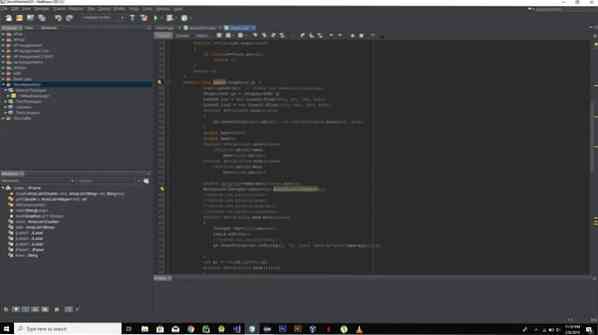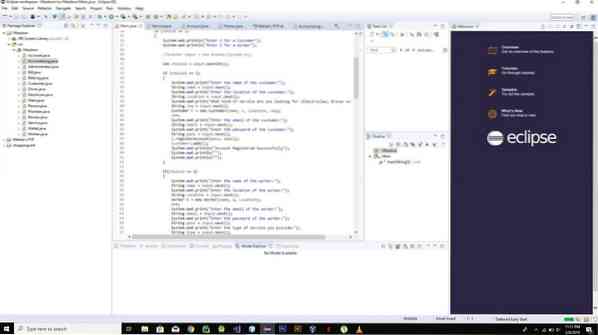To start coding in Java you need to have Java installed, the latest version of Java is 11 but Java 8 is still supported so having any one of these installed will be enough to get you started. Writing a program and compiling it would take some effort as you will have to write the code in a text file and then save it in .java and then have to compile it using terminal, or you can use an IDE and save yourself the time and effort used in this process and get a slew of interesting features.
An Integrated Development Environment or IDE for short, is a software application which helps the user to write and compile code easily by providing features like text editing, debugging plugins etc. while providing compilation by the click of one button. Java has many IDEs but two of the most popular ones are NetBeans and Eclipse.
NetBeans:
NetBeans is an open-source, free Java IDE with a modular architecture. It has a multi-language editor, debugger, profiler, versioning control, and developer collaboration. It also supports the development of other languages like PHP and C++. It integrates all the functionality of Java. NetBeans runs on all major operating systems like Windows, Linux, and Mac OS. It is an easy to install IDE and provides skeleton applications and templates with sample applications as well to help newcomers learn the different features or let developers save time by letting them start coding on a skeleton project so that they don't have to go through the process of implementing modules and pre-written code themselves.
As mentioned above, NetBeans is implemented with a modular architecture. Modules are groups of classes that implement a specific feature so that the developer can use modules to make their work easier. Users can also create new modules which can be provided to other users. Other features in NetBeans include customizability, quick search, plugin manager, Maven support and services.
Plugin Manager provides tools to manage features and plugins provided from the programming languages to other users. While Services window makes it easier for the user to use databases, web services etc. and also manage them in an organized way.
Below is part of what a project open in NetBeans looks like:

Eclipse:
Eclipse is an open-source and free IDE with a modular architecture. It is the most popular Java IDE. It provides support for the development of many languages but it is mostly focused on Java and C/C++ development. Eclipse is compatible to run on all types of operating systems like Windows, Linux, and Mac OS. Eclipse also provides the support for working on documentation and modeling using papyrus and provides tools for implementation of UML, SysML, OCL etc. It also provides the support for Git support, Gradle, Apache Maven etc.
Eclipse is known for its extended support for plugins. It provides the support for users to make their own Plugin Development Environment or PDE to make plugins. It also provides customizability, GUI building, reporting etc. Eclipse also has a Standard Widget Toolkit or SWT, which is used to access and use GUI elements from the operating system on which the program is being developed. Eclipse also provides also used to provide android development tools but was ended in 2015.
Below is part of what a project open in Eclipse looks like:

NetBeans vs Eclipse:
While both IDEs are free, open-source and provide the same basic functionality they both differ in a lot of ways.
- Firstly, Eclipse provides a really strong extensible tool support and plugin support. While NetBeans also provides great plugin and modules support, it is not as huge as Eclipse.
- Eclipse provides exceptional modeling support for UML, SysML etc. based projects, while NetBeans needs a lot of extensions to support modeling.
- Eclipse uses a custom compiler which sometimes gives it an edge over the normal Java compiler.
- NetBeans, on the other hand, is more user-friendly as one does not need to install plugins, unlike Eclipse many basic plugins come installed in NetBeans.
- Learning to use NetBeans is also easier than Eclipse because of its simpler UI but on the other hand, Eclipse provides different windows and perspectives making it more flexible.
- NetBeans is more stable than Eclipse as with subsequent updates NetBeans is less susceptible to annoying bugs and crashes and because of its huge plugin library, any installation of incompatible plugins can cause problems for your project.
- Both of these IDEs can get slow, but Eclipse has a tendency to get slower than NetBeans.
In the end, both the IDEs are free and you cannot go wrong with any of the two as both provide great environments to develop in any language especially Java. Both have their respective strengths and weaknesses and provide great tools in different areas. It boils down to preference; are you a beginner and want to develop without delving much into plugins etc. and want exceptional Maven support with stability? Choose NetBeans. Do you want to customize your experience to your project and customize plugins accordingly or want to work on modeling or just want to use the most popular Java IDE? Choose Eclipse. Like stated above, both are great at what they do and in the end, they will get the job done.
About the author

Zeeman Memon
Hi there! I'm a Software Engineer by degree, Blogger by skills who loves to write about tech, develop websites & do SEO. You can reach out to me on LinkedIn.
View all posts Phenquestions
Phenquestions


